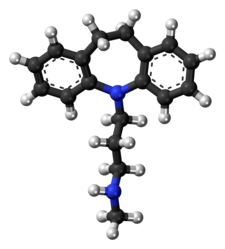Desipramine
 | |
 | |
| Clinical data | |
|---|---|
| Trade names | Norpramin, Pertofrane, others |
| Other names | Desmethylimipramine; Norimipramine; EX-4355; G-35020; JB-8181; NSC-114901[1][2][3] |
| AHFS/Drugs.com | Monograph |
| MedlinePlus | a682387 |
| Routes of administration | Oral, intramuscular injection |
| ATC code | |
| Legal status | |
| Legal status | |
| Pharmacokinetic data | |
| Bioavailability | 60–70%[6] |
| Protein binding | 91%[6] |
| Metabolism | Liver (CYP2D6)[7] |
| Elimination half-life | 12–30 hours[6] |
| Excretion | Urine (70%), feces[6] |
| Identifiers | |
| |
JSmol) | |
| |
| |
| (verify) | |
Desipramine, sold under the brand name Norpramin among others, is a
Medical uses
Desipramine is primarily used for the treatment of depression.
Side effects
Desipramine tends to be less
Overdose
Desipramine is particularly toxic in cases of overdose, compared to other antidepressants.[15] Any overdose or suspected overdose of desipramine is considered to be a medical emergency and can result in death without prompt medical intervention.
Pharmacology
Pharmacodynamics
| Site | Ki (nM) | Species | Ref |
|---|---|---|---|
| SERT | 17.6–163 | Human | [17][18] |
| NET | 0.63–3.5 | Human | [17][18] |
| DAT | 3,190 | Human | [17] |
| 5-HT1A | ≥6,400 | Human | [19][20] |
| 5-HT2A | 115–350 | Human | [19][20] |
| 5-HT2C | 244–748 | Rat | [21][22] |
| 5-HT3 | ≥2,500 | Rodent | [22][23] |
| 5-HT7 | >1,000 | Rat | [24] |
| α1 | 23–130 | Human | [19][25][18] |
| α2 | ≥1,379 | Human | [19][25][18] |
β |
≥1,700 | Rat | [26][27] |
| Cav2.2 | 410 | Human | [28] |
D1 |
5,460 | Human | [29] |
D2 |
3,400 | Human | [19][25] |
| H1 | 60–110 | Human | [19][25][30] |
| H2 | 1,550 | Human | [30] |
| H3 | >100,000 | Human | [30] |
| H4 | 9,550 | Human | [30] |
| mACh | 66–198 | Human | [19][25] |
| M1 | 110 | Human | [31] |
| M2 | 540 | Human | [31] |
| M3 | 210 | Human | [31] |
| M4 | 160 | Human | [31] |
| M5 | 143 | Human | [31] |
| σ1 | 1,990–4,000 | Rodent | [32][33] |
| σ2 | ≥1,611 | Rat | [16][33] |
| Values are Ki (nM). The smaller the value, the more strongly the drug binds to the site. | |||
Desipramine is a very potent and relatively selective
Desipramine has the weakest
Pharmacokinetics
Desipramine is the major metabolite of imipramine and lofepramine.[42]
Chemistry
Desipramine is a
History
Desipramine was developed by
Society and culture
Generic names
Desipramine is the
Brand names
Desipramine is or has been marketed throughout the world under a variety of brand names, including Irene, Nebril, Norpramin, Pertofran, Pertofrane, Pertrofran, and Petylyl among others.[2][3]
References
- ^ ISBN 978-1-4757-2085-3.
- ^ ISBN 978-3-88763-075-1.
- ^ a b c d "Desipramine - Drugs.com". drugs.com.
- FDA. Retrieved 22 Oct 2023.
- ^ Anvisa (2023-03-31). "RDC Nº 784 - Listas de Substâncias Entorpecentes, Psicotrópicas, Precursoras e Outras sob Controle Especial" [Collegiate Board Resolution No. 784 - Lists of Narcotic, Psychotropic, Precursor, and Other Substances under Special Control] (in Brazilian Portuguese). Diário Oficial da União (published 2023-04-04). Archived from the original on 2023-08-03. Retrieved 2023-08-16.
- ^ ISBN 978-1-60913-345-0.
- S2CID 37529573.
- ^ ISBN 978-0-07-162442-8.
- PMID 23914752.
- PMID 25238582.
- ^ "UpToDate". www.uptodate.com.
- PMID 22161371.
- PMID 25246131.
- ^ "Desipramine Hydrochloride". Martindale: The Complete Drug Reference. London, UK: Pharmaceutical Press. 13 December 2013. Retrieved 17 July 2014.
- PMID 19031375.
- ^ a b Roth BL, Driscol J. "PDSP Ki Database". Psychoactive Drug Screening Program (PDSP). University of North Carolina at Chapel Hill and the United States National Institute of Mental Health. Retrieved 7 May 2022.
- ^ PMID 9537821.
- ^ PMID 9400006.
- ^ S2CID 21236268.
- ^ PMID 3816971.
- S2CID 24889381.
- ^ PMID 9686407.
- PMID 2533080.
- PMID 8394362.
- ^ PMID 6086881.
- PMID 3790168.
- S2CID 19490821.
- PMID 16844100.
- PMID 17850785.
- ^ S2CID 14274150.
- ^ PMID 8100134.
- PMID 2877462.
- ^ S2CID 26491662.
- ^ ISBN 978-0-7817-6214-4.
- PMID 6384207.
- ^ ISBN 978-0-323-41691-7.
- ISBN 978-0-8493-5680-3.
- ISBN 978-1-55009-248-6.
- ISBN 978-1-4615-5957-3.
- ISBN 978-1-58562-933-6.
- ISBN 978-1-4377-2190-4.
- PMID 2891742.
- ^ ISBN 978-94-007-5805-6.
- ISBN 978-0-7817-6879-5.
- ISBN 978-0-471-95052-3.
- ISBN 978-3-527-64632-6.
- ISBN 978-1-56053-470-9.
- ISBN 978-0-19-162675-3.
- ^ Chambers M. "Desipramine dibudinate". ChemIDplus. U.S. National Library of Medicine.
- ^ PMID 19557250.
- ISBN 978-0-7817-2845-4.
- ISBN 978-94-011-4439-1.
